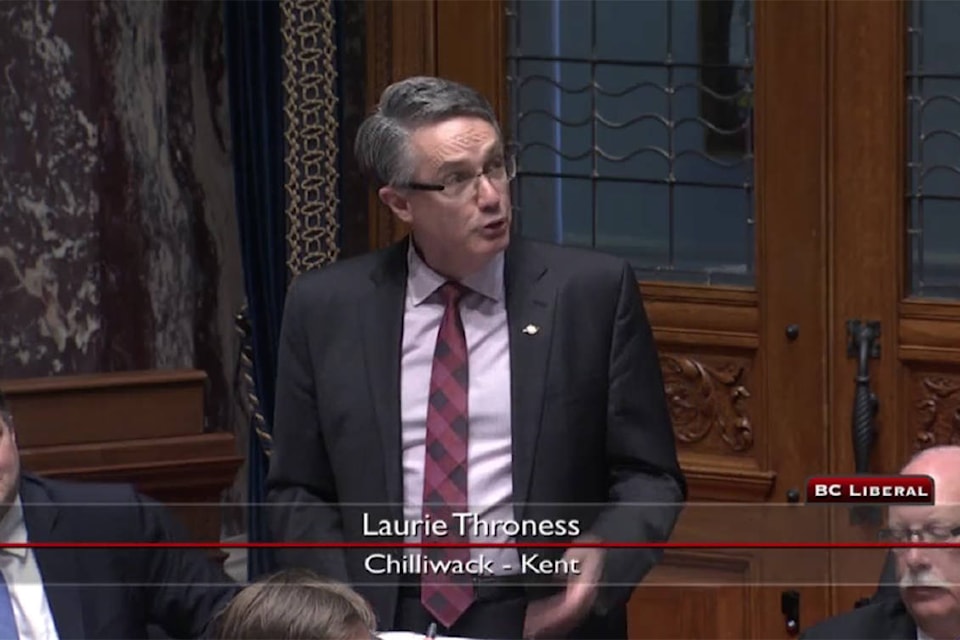Chilliwack-Kent MLA Laurie Throness is calling for “sufficient, rational and equitable” distribution of family doctors across British Columbia.
The MLA spoke on the topic in the Legislature recently, framing it as a question of which should come first, the health needs of the people, or the “free agency” of doctors?
He suggested “the government, or perhaps the College of Physicians and Surgeons,” could direct doctors based on the needs of a particular region, in terms of which specialties to pursue, or in which communities to practise.
Almost 25 per cent of Chilliwack residents do not have a family doctor, which motivated the MLA to look for solutions.
“In fact, one million British Columbians do not have access to a family physician, and the crunch is only going to get worse as baby boom physicians retire,” said Throness.
The MLA had an idea about curbing some aspects of that free agency that doctors enjoy.
“Government can and should train more of them, but there is another solution that wouldn’t cost a penny. We have a command and control health system where managers give direction to everyone — to nurses, to lab techs, to 27,000 workers, for example, in the Fraser Health Authority.”
It is not a “sign of disrespect” to suggest offering doctors some direction in a similar way.
“This respects the needs of patients,” Throness continued. “However, we don’t take the same approach with doctors. We train them, and then we set them free to make their own decisions.”
“Doctors can work the hours they want. They can set up a practice wherever they want, move to or from a community whenever they like, or they can specialize at will.”
It’s something that would only impact future doctors, who would learn after graduation that there will be “parameters around their practice” in B.C.
“We have to answer this basic question. What comes first: the health needs of the people of B.C. or the free agency of doctors? The needs of the people of B.C. must come first, so I call upon the government to bring before this House policy or legislation that will ensure a sufficient, rational and equitable distribution of family doctors across every area of this province and into the future.”
Dr. Trina Larsen Soles, president of Doctors of B.C., (formerly the BC Medical Association) pointed out that the answer is not simply a matter of redistributing physicians geographically.
“It’s that we don’t have enough to begin with,” she said.
In terms of the specialization, she noted that doctors can’t specialize at will either, as suggested by the MLA.
“The comments imply you can pick whatever specialty you want to be,” she said. “But there are only a certain number of residency seats available for each specialty.”
Students apply at the beginning of their fourth year for a residency in an area of specialization, and once matched, that will be their graduate path of study for about five years.
“That determines what kind of doctor they will be. It’s a highly competitive process. Generally there are not enough residency program seats for the applicants who apply for a match.”
Last year there were 68 medical school graduates who were not able to be matched to a residency program across Canada, and doctors can’t practise without being a resident.
“So the comment about willy-nilly choosing what they want to do is not accurate,” said Dr. Larsen Soles.
What about the freedom to set up a practice anywhere one chooses?
“In theory I could hang out a shingle in any community,” she said. “But a medical practice is a small business, and the practicalities around establishing a viable business make that challenging.”
Chilliwack is not unique, as every community is struggling with the doctor shortage, but there are positive signs on the horizon, the doctor stated.
Provincial officials and the Doctors of B.C. have been looking at various mechanisms to expand the ways of providing primary care.
“In Chilliwack, they have had some success in this regard,” said Dr. Larsen Soles, referring to the Chilliwack Division of Family Practice’s Patient Attachment Mechanism (PAM) as well as the Chilliwack Primary Care Clinic (CPCC), where especially vulnerable patients, or those requiring complex care can be seen in a clinic.
They are triaged, stabilized medically, and then attached to a doctor in the community. So a patient who seeks primary care in CGH emergency, can eventually be linked with a family physician through the clinic (CPCC), with a team approach to addressing the medical care and social issues. That reduces ER visits and hospital stays.
“Chilliwack is chipping away at it,” she said, referring to the number of unattached patients being connected with family doctors or practitioners.
Through PAM and the CPCC they have attached 4324 patients in just under four years.
So Chilliwack may be onto to something.
“What we think will work is the model that Chilliwack has established for the primary care clinic,” said Dr. Larsen Soles, calling the work “foundational” toward a model that will likely go province-wide.
@CHWKjourno
jfeinberg@theprogress.com
Like us on Facebook and follow us on Twitter.

